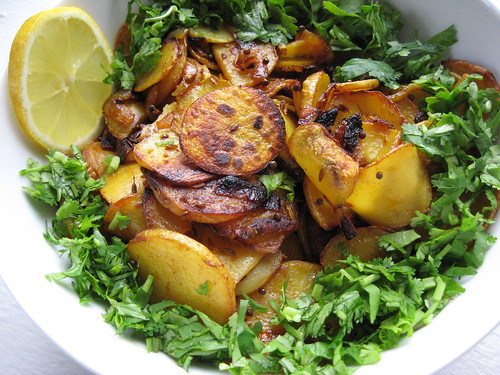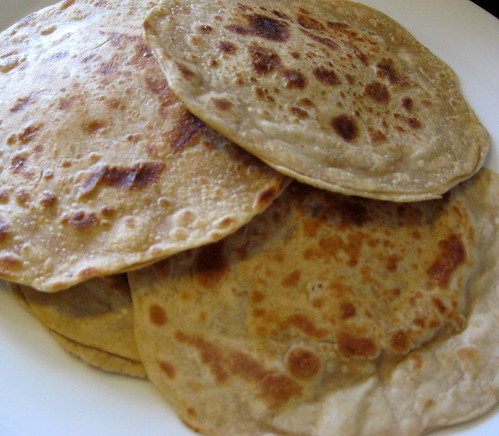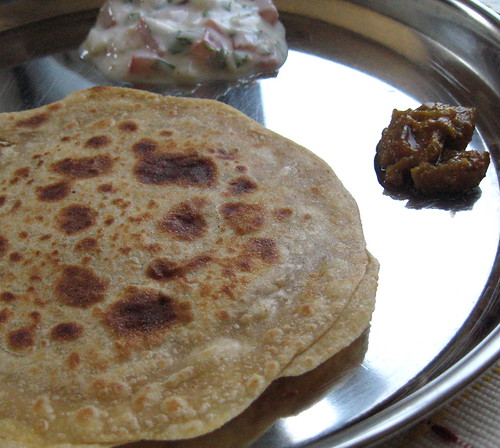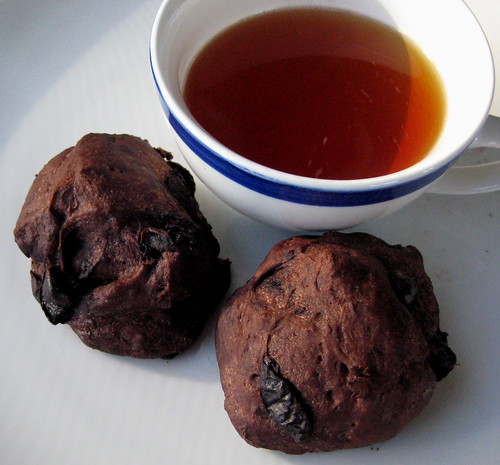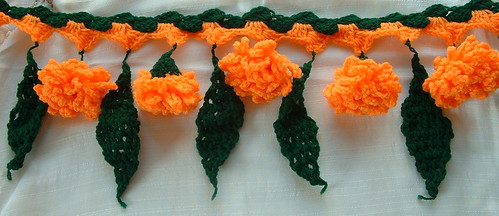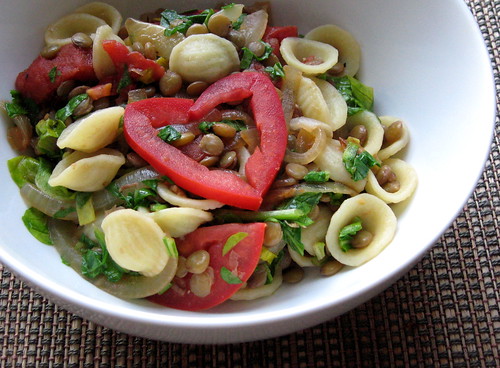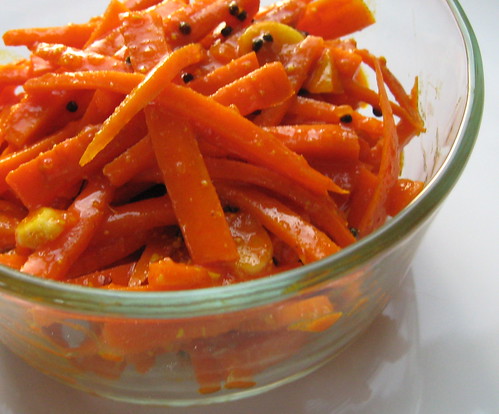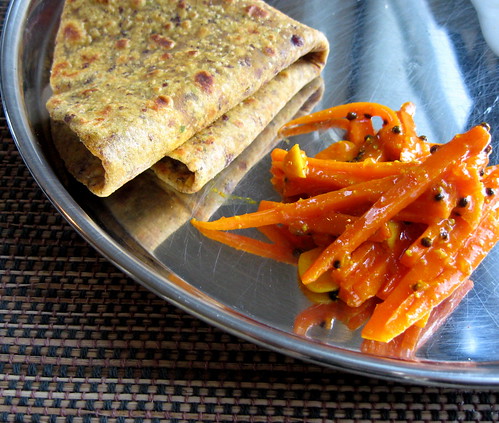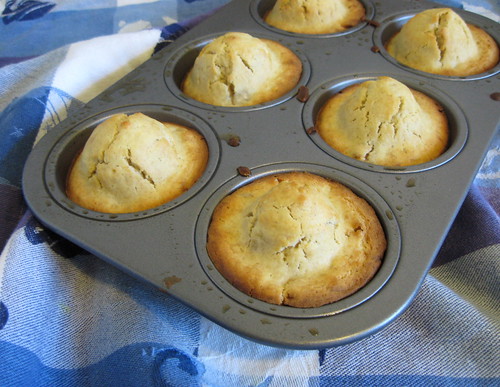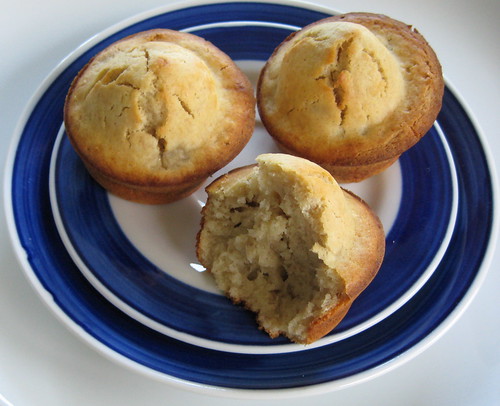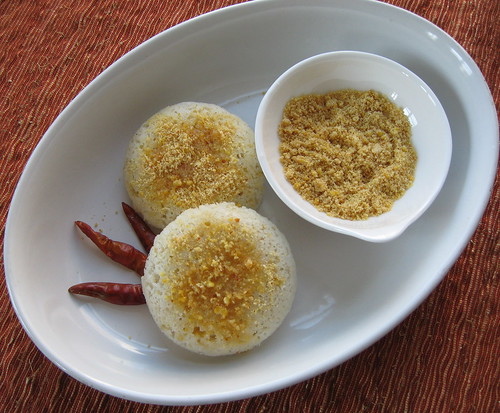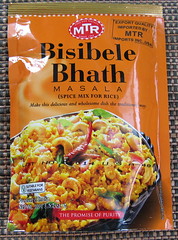The myriad cuisines of India all love their vegetables! Veggies are diced and sliced, grated and mashed, stir-fried and curried into hundreds of vegetable dishes. In this series, the A to Z of Indian Vegetables, we take an alphabetical journey through the various avatars of vegetables relished in Indian cuisine. For each letter, we will make a tasty vegetable dish that illustrates one manner in which vegetables are savored in India. The "P" of Indian Vegetables
The "P" of Indian VegetablesThe letter
P inspired forty
phenomenal Indian flavors!
Let's start with a array of
P vegetables: the first is colorful and chubby , followed by nine veggies that all happen to be painted in myriad shades of green, and the last is a popular starchy root!
First up, the
Pepper: an
potent word in the culinary world. It can mean anything from
peppercorns that constitute the most basic seasoning, to the dizzying array of
chili peppers that provide the kick and the zing in a multitude of cuisines, to the chubby vibrant
bell peppers that are mild and tasty enough to be savored as vegetables.
TC of
The Cooker takes advantage of the hollow insides of the colorful peppers. She stuffs pepper halves with a savory mixture of vegetables, potatoes and spices, then bakes them to perfection. The resulting
Stuffed Peppers are versatile delights that can be enjoyed as an appetizer or a main dish.
The next vegetable is the
Pea, the
pint-sized green gems
packed in their pod. Peas are such a versatile vegetable, used in dozens of different ways in Indian cuisine. Today, we get to eat them in the tastiest way possible, in two delicious appetizers, both
P words!
Dhana of
Fresh Kitchen chooses to make
pattice. Now, we all know what a "patty" is: usually a savory flattened cake of some kind. But in India, the unique term "pattice" refers to a turnover consisting of puff pastry enclosing a tasty filling of some sort. In bakeries all over India, across small towns and megacities, patties (pattices?) will be made and sold like hot cakes every single day (confused metaphor there, but you get the picture). Dhana now teaches us to make these delights in our own home: she makes a savory filling of peas, corn and spinach, then drapes some ready-made biscuit dough over it to makes this appetizing
Peas and Corn Pattice.
Sharmi of
Neivedyam chooses to make
potlis. A "potli" is a cute little purse or moneybag that can be closed with a drawstring. Sharmi's adorable edible potlis are made of home-made pie dough, and contain a treasure of spicy potato and peas. Go steal a look at these artistic
Potlis with Potatoes and Peas.
Coming up next is the long, tapering,
placid
Plantain, the family that includes bananas. Some varieties of the starchy plantain are especially wonderful for cooking.
A Cook of
Live To Cook cooks them in a very interesting Tamil style called
Plantain Paniyaram, or puffy, golden brown, savory pancake balls.
The next vegetable is a
proud member of the
prized family of green leafy vegetables:
Palak, Hindi for spinach. Here is a vegetable that is inexpensive, nutritious, easily available and that cooks in mere seconds. Here are four ways with the versatile spinach...
The first course is a steaming hot cup of soup:
Ramya of
Mane Adige cooks spinach with a flavorful combination of onion, ginger, cinnamon and cloves, then adds some tomatoes and corn to make this nutritious and utterly slurpable
Palak Corn Soup.
Next, a popular appetizer:
Swapna of
Swad makes
Palak Pakoras that take minutes to make and mere seconds to disappear, blending spinach with chickpea batter and spices, then frying spoonfuls of the batter until golden brown.
Tee of
Bhaatukli makes a cool recipe for summer: tasty spinach dumplings in a yogurt sauce. Her
Paalak Dahiwade are a smart way to sneak in vegetables into a beloved snack.
Then,
Rinku of
Cooking in Westchester illustrates that spinach can be teamed with other foods to make quick non-fussy everyday meals. She combines bright green spinach with deep red kidney beans to make a pot of colorful
Palak Rajma.
Following close is another green vegetable, with tightly
packed
pale green leaves:
Pattagobhi, Hindi for cabbage. "patta" means leaves, and "gobhi" means cabbage, the close relation, the cauliflower is called the "phulgobhi" where "phul" means flower.
Musical of
Musical's Kitchen makes a complete
Home-style meal: she cooks the
Pattagobhi together with
Purple Potatoes, and serves this with a dal made using
Peas...comfort food at its best!
The next vegetable is beloved in India- a cute
petite squash called
Parwal in Hindi and ivy gourd or
pointed gourd in English.
Richa of
As Dear As Salt eats a delicious dish featuring parwal at a restaurant, then comes home and recreates us in her own kitchen, then shares the recipe for
Parwal and Kale Chane.
Then comes a huge
prickly tropical fruit: the
jackfruit or
Panasa.
Dee of
Ammalu's Kitchen makes a festive dish with canned jackfruit, a stir-fry with an aromatic tempering of mustard seeds,
Panasa Pottu Koora.
Then comes another green vegetable with an interesting
patterned skin, the
bitter gourd, called
Pavakkai in Tamil and
Pavakka in Malayalam. Bitter gourd is, well, too bitter for many palates but it has its fans, and there are certain ways of cooking it that lower the bitterness and bring out the true flavor....like these two:
Sheela of
Delectable Victuals cooks this vegetable by the method of
Pan-frying, a useful cooking method for rustling up quick and tasty vegetable dishes. Her
Pan-fried Pavakkai is a wonderful side dish, and the post has many useful tips for cooking with this vegetable.
Sigma of
Live To Eat turns the bitter gourd into a
Pachadi, or yogurt-based salad. In her step-by-step recipe, one can see how minced bitter gourd is fried until golden, then seasoned with tempering, a spicy coconut paste and yogurt to make a cool
Pavakka Pachadi with complementary bitter, tangy and spicy flavors.
The next veggie is a
poised and
pretty, long strands of green blending into white...
Piyajkoli, the poetic Bengal word for scallions/ green onions/ spring onions.
Sandeepa of
Bong Mom's Cookbook makes a quick and delicious stir-fry with scallions- her
Piyajkolir Tarkari has a burst of flavors from scallions, potatoes and shrimp, with the aroma of nigella seeds to spice it up.
Then comes a summer favorite; mint or
Pudina. With its
pleasant sweet flavor and distinctive cool aftertaste, mint adds a special something to many Indian dishes.
Madhuli of
My Foodcourt created a recipe of her very own: stir-frying tofu in a fragrant mint paste, with a tangy touch of chaat masala to make this
Pudina Tofu Stir-fry. Well, this experiment looks like a complete success to me!
The last vegetable is #1 when when it comes to popularity, none other than the
pre-eminent
Potato!
Swapna of
Swad gives the potato a glowing representation by cooking it with eggs in a famous
Parsi brunch dish,
Papeta-Pur-Eedu.
Now come four
P foods that are
popular,
prominent and
precious in the world of Indian cuisine!
First comes
Paneer: the milky, mild Indian cheese. Un-aged and rennet-free, paneer is easy to make at home and versatile in its uses. We have five paneer dishes here, all crowd-pleasers!
Now that barbecue season is upon us, it is time to make some juicy paneer kebabs. Paneer is a non-melting cheese; upon grilling, it becomes tender and flavorful and eagerly absorbs the flavors of the marinade.
Sreelu of
Sreelu's Tasty Travels takes this Indian grilled staple to the next level: she skewers chunks of paneer together with a whole host of
P goodies...
Pineapple,
Pepper,
Pudina (Hindi for mint),
Pyaaz (Hindi for onion). The combination of the spicy paneer with the smoky sweetness of the vegetables and the aroma of the herbs results in this
picture-
perfect
platter of
Paneer Kebabs!
Pooja of
Khaana Pina talks about the nostalgia of street food in the city of Pune. She then recreates one of her favorite street foods,
Paneer Kathi Kabab, with a detailed recipe so we can all try it too! Also, check her blog for many
interesting posts about the "rainbow colors of food".
Aarti of
Aarti's Corner was inspired by the Vietnamese and Indonesian pastries called
lumpia. She makes a spicy mixture of paneer and cabbage, then stuffs it into a freshly made dough and rolls it into a cigar shape. The roll is fried to perfection to make these innovative and tempting
Paneer Lumpia.
Mahek of
Love 4 Cooking makes a classic tomato-based curry,
Paneer Jhalfrezi. The classic trio of onion-pepper-tomato combines with classic North Indian spices and soft paneer to yield lip-smacking results!
Swapna of
Swad tasted paneer biryani made by a friend and loved it so much that she wheedled the recipe out of him! She now shares the recipe for this popular
Paneer Biryani with all of us, with neat step-by-step instructions, complete with pictures.
The final paneer recipe is the classic combination of paneer with spinach, the
Palak Paneer. We have two recipes here...
Neelam of
Recipe Factory shares an easy recipe to make the restaurant favorite,
Palak Paneer, in your very own kitchen.
Lakshmi of
Veggie Cuisine shares a fellow bloggers' tried-and-tested recipe for another delicious version of
Palak Paneer.
Second comes
Pulao, or pilaf or pulav...all terms for flavored rice dishes. A pulao offers an open-ended opportunity to a cook- a blank canvas to paint with spices and veggies, nuts and dried fruits as one likes: rice+ innovation= pulao!
Vani of
Mysoorean shares a recipe for a
Plain Pulao which does not sound that plain to me at all- it is cooked in a rich mixture of water and milk and is redolent with whole spices and herbs. To make a complete feast out of it, Vani serves the pulao with some tasty egg curry and crisp
Potato wedges.
Ramya of
Sena's Rasoi makes the ever-popular
Peas Pulav, with a recipe that is elegantly simple- a few ingredients come together in an uncomplicated way to make a tasty meal in minutes.
Third comes
Papad: thin, dried, brittle discs that can be roasted or fried into crunchy treats. The papad or
papadum can make every meal special (pulao and papad happens to be a particularly well-loved combination). One wildly popular brand of papad, Lijjat papad, also happens to be a very interesting
story of women's empowerment.
Swapna of
Swad is inspired by her aunt's recipe and shares a way to make a crunchy tea-time snack,
Papad Pohe.
Fourth comes
Puri: a deep-fried bread that makes for a special treat. Dough is rolled out into thin discs and deep-fried to puffy, golden goodness. Puris can be made in a dozen different ways; the plain puris are generally served with spicy curries, while the flavored puris can be enjoyed by themselves or dipped into a chutney. We have three stellar examples here...
Reena of
Spices of Kerala makes plain whole-wheat puris, then goes on to serve them with a spicy and aromatic vegetable made with potato and fenugreek (a match made in heaven!), resulting in this appetizing and festive meal of
Poori with Aloo Methi.
Manasi of
A Cook At Heart kneads spinach and wheat flour together, then rolls out the dough into little
Palak Puris. Tasty, puffy and crisp, these puris are the stuff of school picnic memories for many of us!
Asha of
Aroma/Foodie's Hope minces up some aromatic mint leaves and kneads them into a spicy dough to make these lovely fried
Pudina Puris. Served with some tasty tomato chutney, these quick puris sound like the perfect tea-time snack!
Coming to the regional specialties, first up is
Puttu, a cylindrical steamed rice cake.
Reena of
Spices of Kerala explains that,
"Puttu and Kadala curry (Black chana curry) is Kerala’s very own breakfast". As they say, try, try and you will succeed, and here, Reena shares her puttu success story with a tried-and-tested recipe for
Puttu and Chana Curry.
Then comes
Pithla, a rustic curry made with chickpea flour.
Aarti of
Aarti's Corner makes the classic combination of
Pithla Bhakri and adds that she served
"pithla with bhakris, rice, buttermilk and spring onion…. A perfect marathi meal, ideal for a weekend...". for a simple meal that is rich in taste.
Next comes an elaborate appetizer/ side dish that can only be described as edible art:
Patra, also known as patode or patrode. Giant leaves of the taro plant (they are also called elephant ears!) are spread with a savory paste, then rolled and steamed. In the style of Swiss rolls, these steamed rolls can be sliced, resulting in a beautiful spicy treat. We have two recipes for patra...
Anita of
A Mad Tea Party assures us that,
"Preparing alu wadi (wadis made with taro leaves) is somewhat labour-intensive, but not hard". She proceeds to write a beautifully detailed account of the preparation of the delicate
Patode, complete with pictures that will make you want to run into the kitchen and make them right away.
Roopa of
My Chow-Chow Bhath tells us that,
"Back in my hometown, we grow these leaves in our backyard is very handy to use in case we are short of veges". I remember the taro plant in my parents' backyard too! Roopa gives a delicious step-by-step recipe for
Patrode/Patra with handy tips for serving the sliced rolls, and for freezing them.
Next comes a signature savory pancake:
Pesarattu, a wholesome dosa made with a batter of rice and lentils (moong dal). A popular way to serve pesarattu is with a stuffing of upma ( a savory dish made with semolina). We have two versions of this filling breakfast/ tea-time treat...
Prema of
My Cookbook explains that
"Pesarattu is a key item in Andhra cuisine" and goes on to share a detailed recipe for making
Pesarattu with Upma that is thin and crispy, filled with chopped onions and chilies.
Sukanya of
Hot 'N Sweet Bowl talks about her love for this dosa...
"Once my family and I went to Trupati and we found this pesarattu in almost all the restaurants.. From that time Pesarattu became my families favorite dish." She provides recipes for the whole menu:
Pesarattu with Uppma, and a flavorful ginger chutney.
Next comes a distinctive style of cooking vegetables: called
Patoli in Andhra Pradesh and
Parippu Usli in Tamil Nadu. In this method, a mixture of lentils and spices are ground to a paste, then cooked by steaming and crumbled to bits. The tasty lentil bits can be mixed in with any vegetable to make a dry curry that is nutritious and protein-rich. We have two versions to learn from...
Suma of
Veggie Platter makes three traditional versions of the
Patoli to demonstrate the versatility of this method, pointing out that it is
"An easier, smarter way to feed the family, the nutritious stuff".
Bee and Jai of
Jugalbandi show us a way to get creative with the basic method and adapt it to all kinds of vegetables; they take advantage of seasonal produce to make some
Patoli with Asparagus. To make everyday cooking more efficient, they share a useful tip:
"Make extra batches of the lentil paste and freeze for later use".
The next
P food may not be distinctly Indian, but it sure has an international fan following:
Pasta!
Deepa of
Recipes 'N More raids her pantry and whips up a simple and tasty lunch of
Pasta with onions, peppers and tomato sauce.
As we start winding down this round-up, it is time for a bite of something sweet. One stove-top
pudding that is a popular sweet in its many avatars (can be made with wheat/ rice/ noodles) is the
Payasam, the South Indian counterpart of the
Kheer.
Sushma of
Sunkiran's Recipe Source gives us a taste of some rich and creamy
Payasam made with semolina, with a delicate touch of saffron.
The final dish is a rather mysterious one:
Pidza! Are you
perplexed and
perturbed? To solve the
puzzle, go visit
Coffee of
The Spice Cafe and find out what
Pidza is all about. Two hints: (1) it is the international food of mystery, and (2) it is delicious!
************************************************************
P is for Pachadi with Cabbage: Cool SaladsWe are on a "accompaniments" roll...close on the heels of the chutney, comes the
salad! Unlike most American and European meals, where the salad is usually a separate course, in the Indian
thali, the salad is part of the array of delicious "courses" all beautifully arranged on one large plate. It forms a crunchy, cool counterpoint to the rest of the meal. During the sultry days of summer, a big bowl of raita is a truly refreshing treat.
Indian salads come in many different forms. In a departure from olive oil and mayonnaise, Indian salads are most often dressed with
yogurt or
lemon juice. Other additions are often region-specific. The
raita is the term often used for salads made in North Indian style, usually seasoned with cumin, mint and yogurt. The
kachumbar often has a mixture of onions, tomatoes and cucumbers with a fiery hint of chillies. The Maharashtrian
koshimbir gets a nutty sprinkling of crushed roasted peanuts. The South Indian
pachadi sparkles with an aromatic tempering of curry leaves and mustard seeds with the creamy backdrop of yogurt. Indian salads can range from the really simple to the fairly complicated. Many times, the salad may simply consist of thin slices of beets, cucumbers, carrots, tomatoes and onions, all decoratively arranged on a plate and sprinkled with salt and lemon juice. Other salads may involve complex pastes of coconut and an array of spices.
In my kitchen, I often throw together raitas and pachadis with commonly available vegetables such as radishes, cucumbers and carrots. This is my recipe for a pachadi made with crispy fresh cabbage. I use the classic South Indian tempering and apply it, along with yogurt, to any vegetable I have on hand...and viola: it becomes a pachadi! I have used the crinkly, lacy
Savoy Cabbage. My favorite addition to pachadis:
dahi mirchis...

These are hot chillies that are stuffed with a mixture of yogurt, spices and salt, then dried in the sun. They can be stored, and to use them, one simply pops them in some hot oil for a couple of seconds. That is enough to get them beautifully crisp. Crushed fried "dahi chillies" really takes pachadis to the next level by making the flavor pop! If you plan on using these, add less salt to the salad, because dahi chillies are generally quite salty. The dahi chillies I used were store-bought, but you can certainly
make them at home in dry, sunny weather.
Cabbage Pachadi
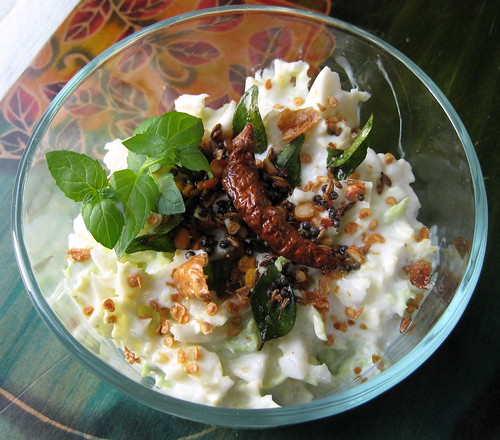
(
makes about 3 cups of salad)
Ingredients:To be mixed:Savoy cabbage, shredded, 2 cups
Plain yogurt, 1 cup (low-fat or non-fat OK)
Milk, 1/4 cup (low-fat or non-fat OK)
Sugar, 1/4 tsp
Salt, to taste
Other ingredients:Oil, 1 tsp
Dahi mirchi, 3-4 (see note in recipe introduction)
Cilantro, minced, 2 tbsp
Mint, few leaves
Tempering:Mustard seeds, 1/2 tsp
Cumin seeds, 1/2 tsp
Chana dal, 1/2 tsp
Urad dal, 1/2 tsp
Curry leaves, 5-6
Asafoetida, pinch
Method:1. Place all the ingredients "to be mixed" in a large bowl, and stir gently to mix them together.
2. Heat the oil in a small skillet. Fry the dahi mirchis (stuffed chillies) for a few seconds, then remove from oil and set aside.
3. To the remaining oil, add all the ingredients in the "tempering" list and stir until the mustard seeds pop and the dals turn golden. Pour the tempering into the bowl over the cabbage and yogurt.
4. To the bowl, add the cilantro and crushed fried dahi mirchis. Mix well. Top with sprigs of mint and serve.
(Pictured: Cabbage Pachadi gets an elephant ride.)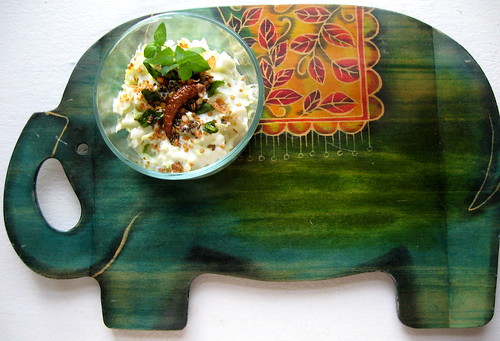 How do you serve this dish?
How do you serve this dish?This salad goes well as part of any South Indian meal. I love eating it with khichdi too. I also mix culinary traditions and eat it with North Indian parathas!
Variations: Pachadis can be made with a variety of different main ingredients. Here is what you could use instead of the cabbage...
1. Mixed vegetables: tomato, cucumber, onion
2. Carrot, shredded
3. Radish,
like so4. Vegetables like okra and eggplant (just cut and saute them first to cook them)
5. Fruits, like mango
Fellow bloggers have come up a colorful
array of salads. Here are some of my favorite finds:
RedRed Pumpkin Raita from
Happy Burp,
PinkBeet Raita from
Musical's Kitchen,
OrangeCarrot Peanut Salad from
Saffron Trail,
Pale GreenCucumber Raita from
Priya's Kitchen,
Bright GreenOkra Pachiri from
Food, In The Main,
Dark GreenSpinach Raita from
My Chow-Chow Bhath,
YellowCorn Salad from
My Rasoi,
and finally, a
sprouts salad:
Mung Sprouts Salad from
The Cook's Cottage,
Previously on the
A to Z of Indian Vegetables...
A is for Aloo Gobi: North-Indian Stir-Fry
B is for Bharli Mirchi: Stuffed Vegetables
C is for Carrot-Cashew Payasam: Desserts
D is for
Dum ki Arbi:
Dum Style of Cooking
E is for Egg-Fried Rice: Rice and Vegetables
F is for Foogath: South-Indian Stir-Fry
G is for Gobi Paratha: Vegetables in Breads
H is for Hariyali Tikki: Vegetables in Appetizers
I is for Idli with Vegetables: Vegetables for Breakfast
J is for Jalfrezi Vegetables: Restaurant Style
K is for Kati Roll: Vegetables and Paneer
L is for Lasuni Dal Palak: Vegetables and Lentils
M is for Malai Kofta: Dumplings
N is for Nargisi Kebab: Vegetables and Eggs
O is for Onion Chutney: Vegetables in Chutneys
 Fried potatoes. The one dish you can count on to be a crowd-pleaser. That you can conjure up from virtually nothing. Pan-fried potatoes, Marathi style, is a dish made with pantry staples- onions, potatoes, and a few everyday spices- cooked to golden brown perfection. The Marathi term for pan-frying is paratne, and potato translates as batata, hence the Marathi name for this dish is paratlele batate.
Fried potatoes. The one dish you can count on to be a crowd-pleaser. That you can conjure up from virtually nothing. Pan-fried potatoes, Marathi style, is a dish made with pantry staples- onions, potatoes, and a few everyday spices- cooked to golden brown perfection. The Marathi term for pan-frying is paratne, and potato translates as batata, hence the Marathi name for this dish is paratlele batate. 